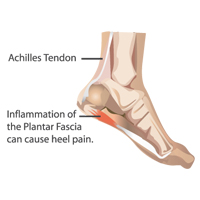Plantar fasciitis is classically characterized by pain in the central to medial plantar heel. It is thought to be caused by chronic inflammation of the plantar fascia due to repetitive strain and trauma to the fascia. There are many other purported causes including, calcaneal spurs and increased intraosseous calcaneal pressure, among others. Many studies have shown inflammatory and histological changes at the origin of the plantar fascia and surrounding structures that are consistent with repetitive strain and degenerative changes including a thickening of the fascia.
Biomechanics has long been looked at when investigating possible causes of injuries. Alteration of the load-bearing characteristics of the foot has been suggested by several studies to be the underlying problem in plantar fasciitis. Microtears and chronic degenerative changes result from the increased tensile stress placed on the fascia due to the changes in biomechanics. Muscle tightness is one factor that can lead to changes in gait mechanics and load bearing of the foot. Hamstring tightness has recently been investigated as a factor in plantar fasciitis and has been shown to induce prolonged forefoot loading due to increased knee flexion during gait. A rapid progression through the contact phase of gait results from increased knee flexion and in turn increases forefoot pressure. The fascia is a fixed-length ligament, so an increase in forefoot pressure results in increased tension at its insertion on the calcaneus. The increased time spent on the forefoot in gait leads to a chronic traction injury that is localized to the hindfoot insertion of the fascia; which is consistent with the symptoms of heel pain.
Biomechanical deficits have long contributed to injuries. Only recently has hamstring tightness been shown to have an effect on plantar fasciitis. Hamstring tightness affects every step, resulting in a biomechanical deficit which may contribute to a tensile overload of the plantar fasciitis. Recent studies suggest that all patients with plantar fasciitis should be evaluated for hamstring tightness. Physical therapy treatment for plantar fasciitis should include hamstring stretching.
More information about Plantar Fasciitis can be found in the PTandMe injury center.
This information was written by Plymouth Physical Therapy Specialists. They are committed to using evidence-based treatments in their practice. This means that their therapists utilize the most current and clinically relevant treatments in their approach to rehabilitation. For more information click here.


